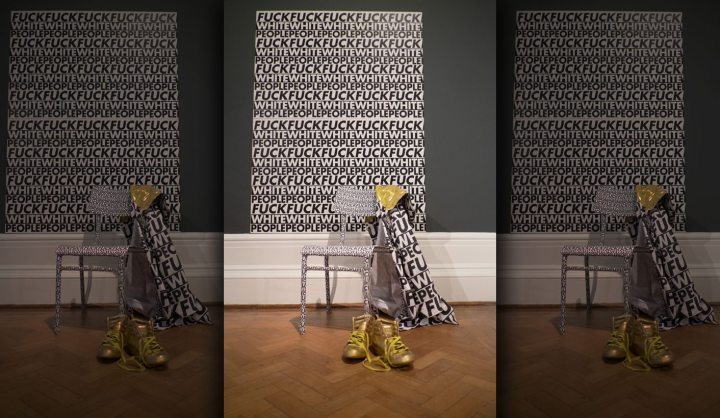Maverick Life, South Africa
Art and Outrage: National Gallery under attack

Table Mountain isn’t the only tinderbox in Cape Town at the moment. The South African National Gallery is fighting fires on two fronts. One is an exhibition featuring a provocative racial statement which has attracted the ire of two political parties. The second is an exhibition on portrayals of women, attacked for featuring so few women artists – alongside the work of a man accused of murder. REBECCA DAVIS paid a visit.
“It’s been interesting,” sighs an Iziko employee when asked about the last few weeks at the South African National Gallery. It’s clear that’s a euphemism. When you enter the museum, a pile of printed statements from the CEO of Iziko at the ticket booth is the first sign of unusual activity. The second is a hyper-vigilant security guard hovering around one piece of art in particular, barking, “No photos!” whenever anyone so much as gestures towards their phone.
The artwork in question is titled fuckwhitepeople wall, chair and goldendean boots. It’s pretty much what it says on the tin: a wall papered with the words “Fuck White People” and a chair upholstered in the same manner, with a pair of golden boots placed in front of it.
The work has drawn the Freedom Front Plus into the realm of art criticism. FF+ leader Pieter Groenewald said he had been approached by members of the public voicing dissatisfaction with the art’s message, which he termed “inflammatory” and “irresponsible” of the museum to exhibit. Groenewald called on the National Gallery to remove it without delay.
The FF+ is nothing if not consistent in its approach to controversial art. In 2012, when a painting by Brett Murray called The Spear briefly inflamed South Africa with its portrayal of President Zuma with his penis exposed, erstwhile FF+ leader Pieter Mulder told Parliament that the majority of Afrikaans people wished to see the painting removed because it was “in poor taste and offensive”.
In response to the party’s criticism of the museum, Iziko CEO Rooksana Omar has released a statement defending its right to show Fuckwhitepeople.
“Cognisant of the provocative nature of the language this work employs, Iziko displayed it along with an explanation (in the artist’s own words) that contextualises the artwork and makes it clear that the artist is not trying to provoke racial hatred or violence,” Omar explains.
Clearly, not everyone is convinced. On the wall opposite the work, the museum has set up a chalkboard for people to write opinions. “Kiss my white ass,” reads one contribution. Another: “Blacks don’t have the socioeconomic or sociopolitical power to implement reverse racism. Even if so… it’s not in our nature to be cruel.” Underneath this, someone else has chalked: “What dream planet are you from?”
On Wednesday, the Cape Party took the objections of the FF+ a step further when individuals representing the party managed to partially cover the artwork with a sticker reading “Love thy neighbour”.
The Cape Party’s stated aim is secession from the rest of South Africa. Explaining its actions at the National Gallery, leader Werner van Tonder said: “If the DA won’t stand up for the minorities in our country, then the Cape Party will!”
Artist Dean Hutton created the work in response to a photograph of student Zama Mthunzi wearing a shirt with the same slogan at the Fees Must Fall protests. On the back of it, it said: “Being Black is Shit”.
The artist told Daily Maverick that the work was produced because “white people in general tend not to feel racialised, or feel answerable for our actions in terms of a racialised identity. We exist in spaces where we very rarely ‘feel white’.”
Hutton added: “The discomfort of feeling racialised in spaces, to honestly ask ourselves if we belong, or how we achieve belonging, is a very necessary part of unlearning oppressive behaviours.”
Not widely reported has been the fact that the artwork forms part of a larger exhibition called The Art of Disruptions, aimed as commentary on “the various controversial and fraught issues that afflict our society today”. Other works on display include kangas by Lawrence Lemaoana, stitched with slogans like: “With Our Boxes Of Matches We Shall Liberate Us”, and “I Did Not Join The Struggle To Be Poor”.
Visitors to the National Gallery face another surprise in the neighbouring rooms, which feature large gaps on the walls. They originally housed an exhibition titled Our Lady, and the gaps exist because many of the artists involved have withdrawn their work out of protest.
The sticking-point here is twofold. Activists led by SWEAT – the Sex Worker Education and Advocacy Task Force – mounted protests outside the museum in recent weeks over the fact that the exhibition included a work by Zwelethu Mthethwa. Mthethwa, an internationally renowned local artist, remains on trial for the alleged murder of 23-year-old sex worker Nokuphila Kumalo.
A petition circulated by activists read: “Though [Mthethwa] will remain innocent until proven guilty, the worth and memory of Ms Kumalo are brutally undermined by the curators’ decision to showcase a work by her alleged murderer.”
The work by Mthethwa – a photograph of an unnamed black woman – was subsequently removed from the exhibition by the New Church Museum, from whom it was on loan. A new addition is a painting by Astrid Warren of Nokuphila Kumalo, based on the only photograph available of her. The work was commissioned by SWEAT in 2015 and is on loan to the museum.
Unhappiness with the Our Lady exhibition extended beyond the inclusion of Mthethwa’s work, however. A letter authored by six female artists – including Penny Siopis and Njideka Akunyili Crosby – demanded that their work be removed due to the “exceptionally problematic nature” of the exhibition. The artists took issue with the fact that despite press material on the exhibition claiming it “celebrate[d] empowered female capacity”, 75% of the work on display was by male artists, with only three black women represented.
The letter from the artists is displayed on an empty space on the wall, while another statement from the museum is mounted on another wall. In it, the museum references a public discussion facilitated on the matter, and thanks the activists for their engagement.
“This public dialogue brought into collective consciousness a very real, current social issue. The pain, hurt and anger expressed must be acknowledged,” it reads. “Museums cannot be static monoliths seated on the periphery of society. Museums have an important role to play and need to constantly engage and reflect the society we serve.”
A curator who requested not to be named told Daily Maverick she believed part of the problem was that the Our Lady exhibition may not have been sufficiently contextualised. The reason it included so many male artists is because it was intended to represent a historical overview of representations of women in art. The earliest work on display dates from 1510.
The exhibition blurb explains: “It is evident that over the centuries, women increasingly emerged from the shadow of religion, but their portrayal continued to be dictated mostly by men. Viewing the older works in Our Lady with the benefit of a contemporary perspective, we are able to free them from the macrohistorical forces that were at play when they were produced.”
The protesting artists say they understand this, but that the old male artwork should “have been supplemented by a broader selection of works which, in juxtaposition with these historical works by men, might have challenged the visual language of patriarchy and given voice to alternative narratives”.
For now, the gaps on the museum’s walls tell their own story of dissent.
In the National Gallery’s guest book, one recent visitor has written in a juvenile hand: “It was lit!” These days, that may be the highest compliment a South African museum can be paid. DM

















 Become an Insider
Become an Insider